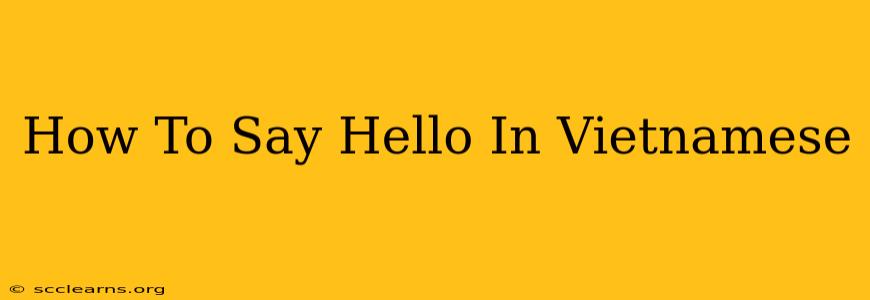Learning a new language can be exciting, and Vietnamese is no exception! Knowing how to greet someone is the first step in any language learning journey. This guide will teach you various ways to say "hello" in Vietnamese, depending on the time of day and level of formality.
Basic Vietnamese Greetings
The most common way to say hello in Vietnamese is "Chào" (pronounced chow). This is a versatile greeting suitable for most situations and times of day. It's a friendly and informal way to acknowledge someone.
Think of "Chào" as your go-to "hello" for everyday use. It's simple, straightforward, and universally understood.
Adding Politeness and Formality
While "Chào" works well in most situations, Vietnamese culture places a high value on politeness. You can add a layer of respect by using these variations:
-
"Chào buổi sáng" (pronounced chow bway-sang): This translates to "Good morning." Use this greeting from sunrise until around midday.
-
"Chào buổi chiều" (pronounced chow bway-chee-ew): This means "Good afternoon" and is appropriate from midday until evening.
-
"Chào buổi tối" (pronounced chow bway-toy): This translates to "Good evening" or "Good night" and is used from evening onwards.
These phrases are slightly more formal and show consideration for the time of day.
Beyond "Hello": More Ways to Greet in Vietnamese
While "Chào" and its variations are excellent starting points, here are a few more greetings you can use to expand your vocabulary and impress native speakers:
-
"Xin chào" (pronounced seen chow): This is a more formal and polite way to say "hello." It's a great option when meeting someone for the first time, speaking to elders, or in more professional settings. Think of it as a more respectful version of "Chào."
-
"Dạ" (pronounced ya): This word is unique to Vietnamese. It's a polite particle often used as a response to a greeting or question, similar to "yes" but much more respectful and humble. Using "Dạ" shows good manners and respect, particularly when speaking to elders or those in positions of authority. For example, if someone greets you with "Chào," you could reply with "Dạ, chào anh/chị" (Yes, hello sir/madam).
Context Matters: Choosing the Right Greeting
The best way to say "hello" in Vietnamese depends entirely on the context. Consider who you're speaking to, the time of day, and the overall setting. While "Chào" is versatile, using the more formal options or adding "Dạ" will show respect and enhance your interactions.
Mastering Vietnamese Greetings: Practice Makes Perfect!
The best way to learn these greetings is to practice! Try using them in conversation, either with a native speaker or through language learning apps. Don't be afraid to make mistakes – it's all part of the learning process. With a little practice, you'll be confidently greeting people in Vietnamese in no time!
Remember to pair your verbal greetings with a friendly smile and a respectful attitude. This will make a strong positive impression and enhance your interactions with Vietnamese speakers. Chúc bạn học tốt! (Good luck with your studies!)

